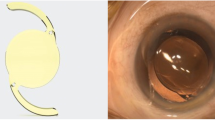Abstract
Purpose
To investigate the effects of light scattering from the surface of hydrophobic acrylic intraocular lenses (IOLs) on visual function.
Methods
A 67-year-old man was implanted with an IOL (MA60BM) in January 1998, but became aware of decreased visual function in May 2008. Observation with a slit lamp revealed light scattering throughout the entire optic of the IOL, which was extracted and replaced. Postoperative visual function improved at 1 month. The cause of light scattering was investigated with a focus on water permeating the IOL material. To confirm the effect of light scattering on visual function, light transmission of the extracted IOL was measured in physiological saline at 33°C, and the simulated retinal image was evaluated in a model eye.
Results
Observation of the extracted IOL showed light scattering from the optic surface layer, the main cause of which was phase-separated water within the IOL material. Light transmission in the extracted IOL was 16.3% lower than that in an unused IOL in the visible range. Moreover, the simulated retinal image was hazy compared to that of the unused IOL.
Conclusion
Severe surface light scattering from an IOL optic may decrease visual function.
Similar content being viewed by others
References
Hollic EJ, Spalton DJ, Ursell PG, Pande MV. Biocompatibility of poly(methyl methacrylate), silicone, and AcrySof intraocular lenses: randomized comparison of the cellular reaction on the anterior lens surface. J Cataract Refract Surg 1998;24:361–366.
Ursell PG, Spalton DJ, Pande MV. Anterior capsule stability in eyes with intraocular lenses made of poly (methyl methacrylate), silicone, and AcrySof. J Cataract Refract Surg 1997;23:1532–1538.
Ursell PG, Spalton DJ, Pande MV. Relationship between intraocular lens biomaterials and posterior capsule opacification. J Cataract Refract Surg 1998;24:352–360.
Nishihara H, Yaguchi S, Onishi T, Chida M, Ayaki M. Surface scattering in implanted hydrophobic intraocular lenses. J Cataract Refract Surg 2003;29:1385–1388.
Yaguchi S, Nishihara H, Kambhiranond W, Stanley MS, Apple DL. Light scatter on the surface of AcrySof intraocular lenses: part I. Analysis of lenses retrieved from pseudophakic postmortem human eyes. Ophthalmic Surg Lasers Imaging 2008;39:209–213.
Miyata K, Otani S, Nejima R, et al. Comparison of postoperative surface light scattering of different intraocular lenses. Br J Ophthalmol 2009;93:684–687.
Werner L, Apple DJ, Kaskaloglu M, Pandy SK. Dense opacification of the optical component of hydrophilic acrylic intraocular lens; a clinicopathological analysis of 9 explanted lenses. J Cataract Refract Surg 2001;27:1485–1492.
Yu AK, Kwan KY, Chan DH, Fong DY. Clinical features of 46 eyes with calcified hydrogel intraocular lenses. J Cataract Refract Surg 2001;27:1596–1606.
Mamalis N. Hydrophilic acrylic intraocular lenses. J Cataract Refract Surg 2001;27:1339–1340.
Nakanome S, Watanabe H, Tanaka K, Tochikubo T. Calcification of Hydroview H60M intraocular lenses: aqueous humor analysis and comparisons with other intraocular lens materials. J Cataract Refract Surg 2008;34:80–86.
Werner L, Storsberg J, Chem D, et al. Unusual pattern of glistening formation on a 3-piece hydrophobic acrylic intraocular lens. J Cataract Refract Surg 2008;34:1604–1609.
Dhaliwal DK, Mamalis N, Olson RJ, et al. Visual significance of glistenings seen in the AcrySof intraocular lens. J Cataract Refract Surg 1996;22:452–457.
Gunenc U, Oner FH, Tongal S, Ferliel M. Effect on visual function of glistenings and folding marks in AcrySof intraocular lenses. J Cataract Refract Surg 2001;27:1611–1614.
Shiokawa Y, Oshika T. Effect of glistening on the optical quality of soft acrylic intraocular lens. Jpn J Vis Sci 2000;21:18–24.
Matsushima H, Mukai k, Nagata M, et al. Analysis of surface “whitening“ of extracted AcrySof intraocular lenses. J Cataract Refract Surg 2009;35:1927–1934.
Author information
Authors and Affiliations
Corresponding author
About this article
Cite this article
Yoshida, S., Matsushima, H., Nagata, M. et al. Decreased visual function due to high-level light scattering in a hydrophobic acrylic intraocular lens. Jpn J Ophthalmol 55, 62–66 (2011). https://doi.org/10.1007/s10384-010-0901-2
Received:
Accepted:
Published:
Issue Date:
DOI: https://doi.org/10.1007/s10384-010-0901-2




